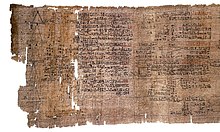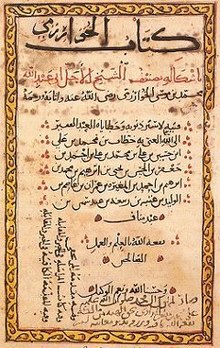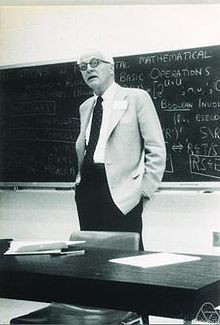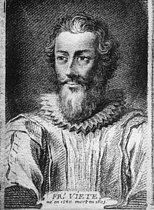User:Phlsph7/Algebra - History
History[edit]

The origin of algebra lies in attempts to solve mathematical problems involving arithmetic calculations, usually in the form of a theory of equations. These developments happend in the ancient period in diverse regions such as Babylonia, Egypt, Greece, China, and India. One of the earliest documents is the Rhind Papyrus from ancient Egypt, which was written around 1650 BCE[a] and discusses how to solve linear equations, as expressed in problems like "A quantity; its fourth is added to it. It becomes fifteen. What is the quantity?" Babylonian clay tablets from around the same time explain methods to solve linear and quadratic polynomial equations, such as the method of completing the square.[1]
Many of these insights found their way to the ancient Greeks. Starting in the 6th century BCE, their main interest was geometry rather than algebra, but they employed algebraic methods to solve geometric problems. For example, they studied geometric figures while taking their lengths and areas as unknown quantities to be determined, as exemplified in Pythagoras' formulation of the difference of two squares method and later in Euclid's Elements.[2] In the 3rd century BCE, Diophantus provided a detailed treatment of how to solve algebraic equations in a series of books called Arithmetica. He was the first to experiment with symbolic notation to express polynomials.[3] In ancient China, the book The Nine Chapters on the Mathematical Art explored various techniques for solving algebraic equations, including the use of matrix-like constructs.[4]

It is controversial to what extent these early developments should be considered part of algebra proper rather than precursors. They offered solutions to algebraic problems but did not conceive them in an abstract and general manner, focusing instead on specific cases and applications.[5] This changed with the Persian mathematician al-Khwarizmi,[b] who published his The Compendious Book on Calculation by Completion and Balancing in 825 CE. It presents the first detailed treatment of general methods that can be used to manipulate linear and quadratic equations by "reducing" and "balancing" both sides.[7] Other influential contributions to algebra came from the Persian mathematicians Thābit ibn Qurra in the 9th century and Omar Khayyam in the 11th and 12th centuries.[8]
In India, Brahmagupta investigated how to solve quadratic equations and systems of equations with several variables in the 7th century CE. Among his other innovations were the use of zero and negative numbers in algebraic equations.[9] The Indian mathematicians Mahāvīra in the 9th century and Bhāskara II in the 12th century further refined Brahmagupta's methods and concepts.[10] In 1247, the Chinese mathematician Qin Jiushao wrote the Mathematical Treatise in Nine Sections, which includes an algorithm for the numerical evaluation of polynomials, including polynomials of higher degrees.[11]
The Italian mathematician Fibonacci brought al-Khwarizmi's ideas and techniques to Europe in books like his Liber Abaci.[12] In 1545, the Italian polymath Gerolamo Cardano published his book Ars Magna, which covered many topics in algebra and was the first to present general methods for solving cubic and quartic equations.[13] In the 16th and 17th centuries, the French mathematicians François Viète and René Descartes introduced letters and symbols to denote variables and operations, making it possible to express equations as mathematical formulas. Their predecessors had relied on verbal descriptions of problems and solutions.[14] Some historians see this development as a key turning point in the history of algebra and consider what came before it as the prehistory of algebra because it lacked the abstract nature based on symbolic manipulation.[15]

Many attempts in the 17th and 18th centuries to find general solutions to polynomials of degree five and higher failed.[16] At the end of the 18th century, the German mathematician Carl Friedrich Gauss proved the fundamental theorem of algebra, which describes the existence of zeros of polynomials of any degree without providing a general solution.[17] At the beginning of the 19th century, the Italian mathematician Paolo Ruffini and the Norwegian mathematician Niels Henrik Abel were able to show that no general solution exists for polynomials of degree five and higher.[18] In response to and shortly after their findings, the French mathematician Évariste Galois developed what came later to be known as Galois theory, which offered a more in-depth analysis of the solutions of polynomials while also laying the foundation of group theory.[19] Mathematicians soon realized the relevance of group theory to other fields and applied it to disciplines like geometry and number theory.[20]
Starting in the mid-19th century, interest in algebra shifted from the study of polynomials associated with elementary algebra towards a more general inquiry into algebraic structures, marking the emergence of abstract algebra. This approach explored the axiomatic basis of arbitrary algebraic operations.[21] The invention of new algebraic systems based on different operations and elements accompanied this development, such as Boolean algebra, vector algebra, and matrix algebra.[22] Influential early developments in abstract algebra were made by the German mathematicians David Hilbert, Ernst Steinitz, Emmy Noether, and Emil Artin. They researched different forms of algebraic structures and categorized them based on their underlying axioms into types, such as groups, rings, and fields.[23] The basic idea of the even more general approach associated with universal algebra was first conceived by the English mathematician Alfred North Whitehead in his 1898 book A Treatise on Universal Algebra. Starting in the 1930s, the American mathematician Garrett Birkhoff expanded these ideas and developed many of the foundational concepts of this field.[24] Closely related developments were the formulation of model theory, category theory, topological algebra, homological algebra, Lie algebras, free algebras, and homology groups.[25]
References[edit]
- Hazewinkel, Michiel (28 February 1994). Encyclopaedia of Mathematics (set). Springer Science & Business Media. ISBN 978-1-55608-010-4.
- Derbyshire, John (2 June 2006). "2. The Father of Algebra". Unknown Quantity: A Real and Imaginary History of Algebra. National Academies Press. ISBN 978-0-309-09657-7.
- Boyer, Carl B.; Merzbach, Uta C. (25 January 2011). A History of Mathematics. John Wiley & Sons. ISBN 978-0-470-63056-3.
- Zwillinger, Daniel (25 November 2002). CRC Standard Mathematical Tables and Formulae. CRC Press. ISBN 978-1-4200-3534-6.
- Smorynski, Craig (3 December 2007). History of Mathematics: A Supplement. Springer Science & Business Media. ISBN 978-0-387-75481-9.
- Higgins, Peter M. (22 October 2015). Algebra: A Very Short Introduction. OUP Oxford. ISBN 978-0-19-104746-6.
- Emch, Gerard G.; Sridharan, R.; Srinivas, M. D. (15 October 2005). Contributions to the History of Indian Mathematics. Springer. ISBN 978-93-86279-25-5.
- Seshadri, C. S. (15 August 2010). Studies in the History of Indian Mathematics. Springer. ISBN 978-93-86279-49-1.
- Waerden, Bartel L. van der (29 June 2013). A History of Algebra: From al-Khwārizmī to Emmy Noether. Springer Science & Business Media. ISBN 978-3-642-51599-6.
- Grätzer, George (15 December 2008). Universal Algebra. Springer Science & Business Media. ISBN 978-0-387-77487-9.
- Knoebel, Arthur (15 December 2011). Sheaves of Algebras over Boolean Spaces. Springer Science & Business Media. ISBN 978-0-8176-4218-1.
- Chang, C. C.; Keisler, H. J. (12 June 1990). Model Theory. Elsevier. ISBN 978-0-08-088007-5.
- Corry, Leo (3 January 2024). "Algebra". Encyclopædia Britannica. Retrieved 25 January 2024.
- Musielak, Dora (23 March 2020). Sophie Germain: Revolutionary Mathematician. Springer Nature. ISBN 978-3-030-38375-6.
- Kvasz, L. (13 January 2006). "The History of Algebra and the Development of the Form of its Language". Philosophia Mathematica. 14 (3). doi:10.1093/philmat/nkj017.
- Sialaros, Michalis (23 April 2018). Revolutions and Continuity in Greek Mathematics. Walter de Gruyter GmbH & Co KG. ISBN 978-3-11-056527-0.
Cite error: There are <ref group=lower-alpha> tags or {{efn}} templates on this page, but the references will not show without a {{reflist|group=lower-alpha}} template or {{notelist}} template (see the help page).
- ^
- Tanton 2005, p. 9
- Kvasz 2006, p. 290
- Corry 2024, § Problem Solving in Egypt and Babylon
- ^
- Tanton 2005, p. 9
- Kvasz 2006, p. 290
- Corry 2024, § The Pythagoreans and Euclid
- ^
- EoM Staff 2020, § Historical survey
- Sialaros 2018, p. 55
- Musielak 2020, p. 36
- Corry 2024, § Diophantus
- ^ Higgins 2015, p. 89
- ^
- Kvasz 2006, pp. 290–291
- Sialaros 2018, p. 55
- Boyer & Merzbach 2011, p. 161
- Derbyshire 2006, p. 31
- ^
- ^
- Tanton 2005, p. 10
- Kvasz 2006, pp. 291–293
- EoM Staff 2020, § Historical survey
- ^ Waerden 2013, pp. 3, 15–16, 24–25
- ^
- Tanton 2005, pp. 9–10
- Corry 2024, § The Equation in India and China
- ^
- ^
- Smorynski 2007, p. 137
- Zwillinger 2002, p. 812
- ^
- Waerden 2013, pp. 32–35
- Tanton 2005, p. 10
- Kvasz 2006, p. 293
- ^
- Tanton 2005, p. 10
- Kvasz 2006, p. 293
- Corry 2024, § Cardano and the solving of cubic and quartic equations
- ^
- Tanton 2005, p. 10
- Kvasz 2006, pp. 291–292, 297–298, 302
- EoM Staff 2020, § Historical survey
- Corry 2024, § Viète and the formal equation, § Analytic geometry
- ^
- Hazewinkel 1994, p. 73
- EoM Staff 2020, § Historical survey
- ^
- Tanton 2005, p. 10
- EoM Staff 2020, § Historical survey
- Corry 2024, § Impasse with radical methods
- ^
- Tanton 2005, p. 10
- Kvasz 2006, p. 308
- Corry 2024, § The Fundamental Theorem of Algebra
- ^
- Tanton 2005, p. 10
- EoM Staff 2020, § Historical survey
- Corry 2024, § Impasse with radical methods
- ^
- Kvasz 2006, p. 314–345
- EoM Staff 2020, § Historical survey
- Corry 2024, § Galois Theory, § Applications of group theory
- ^ Corry 2024, § Applications of group theory
- ^
- EoM Staff 2020, § Historical survey
- Tanton 2005, p. 10
- Corry 2024, § Structural algebra
- Hazewinkel 1994, pp. 73–74
- ^
- EoM Staff 2020, § Historical survey
- Tanton 2005, p. 10
- Corry 2024, § Matrices, § Quaternions and vectors
- ^
- EoM Staff 2020, § Historical survey
- Corry 2024, § Hilbert and Steinitz, § Noether and Artin
- Hazewinkel 1994, pp. 73–74
- ^
- Grätzer 2008, p. vii
- Chang & Keisler 1990, p. 603
- Knoebel 2011, p. 5
- Hazewinkel 1994, pp. 74–75
- ^
- Hazewinkel 1994, pp. 74–75
- Grätzer 2008, p. 338
- Pratt 2022, § 6. Free Algebras


